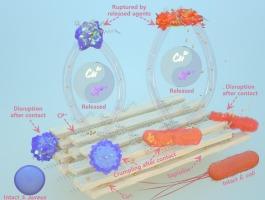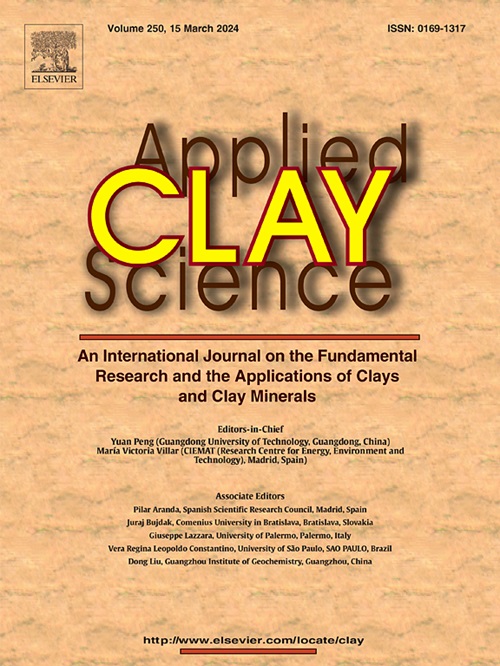Synergistic antibacterial material of cetylpyridinium/Cu2+/sepiolite and its application in thermoplastic polyurethane films
IF 5.3
2区 地球科学
Q2 CHEMISTRY, PHYSICAL
引用次数: 0
Abstract
Seeking non-antibiotic solutions against bacterial infections has become a global priority. Therefore, this work employs sepiolite as the carrier to load cetylpyridinium (CP+) and Cu2+, constructing a CP+/Cu2+/sepiolite (PCS) system with excellent antibacterial and application properties. Sepiolite, serving as a micro-container for storing antibacterial agents, enhances their thermal stability and realizes their “burst + sustained” release. Antibacterial agents improve the organic compatibility of sepiolite and provide a synergistic antibacterial effect. With the released antibacterial agents and contact inactivation effect, PCS at 10 mg/L and 75 mg/L achieve 100 % inactivation of Staphylococcus aureus and Escherichia coli within 120 min, respectively. Furthermore, the sepiolite carrier with an intact fibrous structure facilitates the loading-release and antibacterial activity of agents in PCS. The obtained PCS disperses uniformly in thermoplastic polyurethane and binds tightly with it, improving its mechanical properties. Film of ST-10wt%PCS with 10 wt% PCS inactivates 100 % of Staphylococcus aureus and 93.0 % of Escherichia coli in 4 h, while exhibiting superior elongation at break (263 %) and tensile strength (35 MPa) compared to the pure film (242 % and 30 MPa). Thus, it is evident that the resulting PCS holds promise for the direct use or manufacture of functional products to combat bacterial infections.

十六烷基吡啶/Cu2+/沸石的协同抗菌材料及其在热塑性聚氨酯薄膜中的应用
寻求非抗生素的细菌感染解决方案已成为全球的当务之急。因此,本研究采用海泡石作为载体,负载十六烷基吡啶鎓(CP+)和Cu2+,构建了具有优异抗菌和应用特性的CP+/Cu2+/海泡石(PCS)系统。作为储存抗菌剂的微容器,海泡石提高了抗菌剂的热稳定性,实现了 "爆发+持续 "释放。抗菌剂改善了海泡石的有机相容性,提供了协同抗菌效果。在释放抗菌剂和接触灭活效应的作用下,10 mg/L 和 75 mg/L 的 PCS 可分别在 120 分钟内 100%地灭活金黄色葡萄球菌和大肠杆菌。此外,具有完整纤维结构的海泡石载体有利于 PCS 中药剂的负载释放和抗菌活性。获得的 PCS 能均匀地分散在热塑性聚氨酯中,并与之紧密结合,从而改善其机械性能。与纯薄膜(242% 和 30 兆帕)相比,含有 10 wt% PCS 的 ST-10wt%PCS 薄膜可在 4 小时内灭活 100% 的金黄色葡萄球菌和 93.0% 的大肠杆菌,同时显示出更高的断裂伸长率(263%)和拉伸强度(35 兆帕)。因此,由此产生的 PCS 显然有望直接用于或制造抗细菌感染的功能性产品。
本文章由计算机程序翻译,如有差异,请以英文原文为准。
求助全文
约1分钟内获得全文
求助全文
来源期刊

Applied Clay Science
地学-矿物学
CiteScore
10.30
自引率
10.70%
发文量
289
审稿时长
39 days
期刊介绍:
Applied Clay Science aims to be an international journal attracting high quality scientific papers on clays and clay minerals, including research papers, reviews, and technical notes. The journal covers typical subjects of Fundamental and Applied Clay Science such as:
• Synthesis and purification
• Structural, crystallographic and mineralogical properties of clays and clay minerals
• Thermal properties of clays and clay minerals
• Physico-chemical properties including i) surface and interface properties; ii) thermodynamic properties; iii) mechanical properties
• Interaction with water, with polar and apolar molecules
• Colloidal properties and rheology
• Adsorption, Intercalation, Ionic exchange
• Genesis and deposits of clay minerals
• Geology and geochemistry of clays
• Modification of clays and clay minerals properties by thermal and physical treatments
• Modification by chemical treatments with organic and inorganic molecules(organoclays, pillared clays)
• Modification by biological microorganisms. etc...
 求助内容:
求助内容: 应助结果提醒方式:
应助结果提醒方式:


